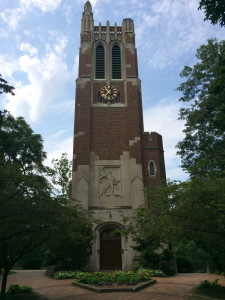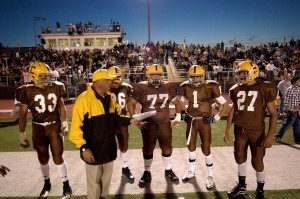Blog: Brown Beginnings: Issue 2
As the release of the non-fiction book The Boys in Brown approaches, author Jon J. Kerr takes readers inside the process. On Tuesdays, the series Brown Beginnings gives readers a behind-the-scenes look at the conception and reporting of the story. Thursdays, he blogs about the writing and publishing steps before launch.
This past weekend I was in East Lansing, Michigan. The city is the home of Michigan State University, where I went to college.
I’ve been back numerous times since I graduated in 1994. Almost every time, my trips are to attend a football game. My movements mirror the pace of Saturday fall campus life–frenetic, excitable and hyperactive. I never have the time to actually see the campus, to open my eyes to what’s beyond my immediate and hurried line of sight.
Sunday, I took the time.
What stuck me was the silence. The campus was stunningly quiet, the opposite of the clamorous nerve center it is during the school year. And while I was walking, I heard bell chimes. They were coming from a nearby tower.
As it turns out, the site of Beaumont Tower, which you see above, is historic. Erected on the tower site a century and a half ago was the first building in the United States for the teaching of scientific agriculture. In my four years in East Lansing and two decades-plus since leaving, I don’t remember taking the time to learn about Beaumont Tower or its historical significance.
Let me be clear–the point of this post is not to self-scold. I don’t mourn the lost memories of chilling with my college friends by the tower (although we would have found creative ways to enjoy ourselves). And I’m not saying you should change your summer vacation plans and take the family back to school. What I’m saying is how we often miss the stories that lie beneath our feet.
By the time I began researching The Boys in Brown in the summer of 2010, Carmel Catholic had been around for almost 50 years. The community had experienced a multitude of historic milestones–the JFK assassination, the Second Vatican Council, the moon landing, the Vietnam War, Watergate, the Reagan Presidency, the fall of Communism, the Michael Jordan era, 9/11, the Iraqi War and the election of our first black president. As a result of these events, our culture changed. And so did Carmel.
But as I spent more time around the characters who would become the book’s protagonists, I kept reminding myself of one question.
In the face of an ever-changing culture, what is the constant truth about these people, about this place?
Or in other words, I needed to find the remarkable stories seeped within the soil.
That didn’t happen overnight.
The first few weeks, all I did was take notes. Strictly observational. No recorded interviews. This was intentional as I had to build trust. I needed the players, coaches and others to get used to my presence. The sooner I was thought of as part the program (and not a reporter), the sooner everyone would begin to open up. I had gotten good advice from Buzz Bissinger, the writer of the legendary book Friday Night Lights. He told me how when he started his reporting for FNL, he didn’t talk to anyone on the record for the first few weeks. Finally, one day at practice, he was approached by one of the Permian High School football players. He asked him who he was and how he could help.
That’s exactly what happened to me.
It was during a pre-season workout in August. I was standing on the sidelines, notebook in hand. Coming off the field was Michael Cohen, a senior defensive lineman for the Corsairs. Michael took off his helmet.
“What are you writing down?”
“Just stuff I notice. Observations, that sort of thing,” I said.
“There’s a lot going on here. You’re going to need a lot of paper.”
That’s when I felt the ground beneath me shake for the first time.






